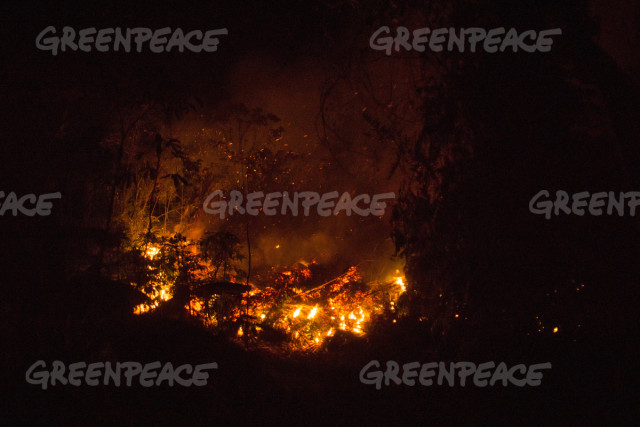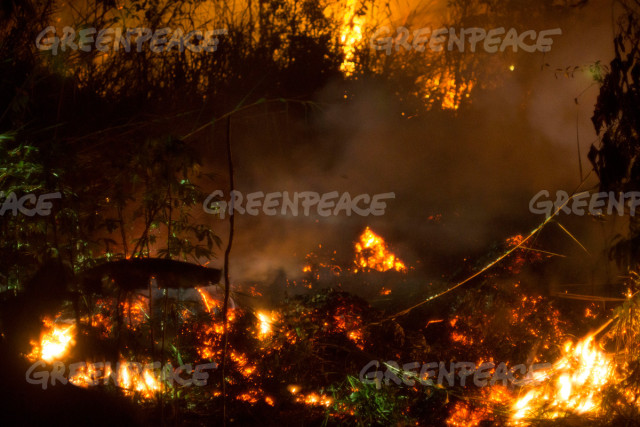
“There can be no question that the root cause of the fires crisis is decades of forest and peatland destruction by pulp and palm oil companies.These fires and the toxic haze will return year after year until plantation companies turn off their bulldozers. Businesses, must demonstrate serious efforts to work together to prevent forest fires by stamping out this reckless destruction and start protecting rainforests and peatlands,” said Teguh Surya, Indonesia Forest Campaigner at Greenpeace Southeast Asia.
“The data that we’ve released indicate that the company associated with the most fire hotspots is Asia Pulp & Paper. This is not surprising. Firstly, they are the largest concession holder in Indonesia and have a legacy of deforestation, particularly in the south of Sumatra where a lot of these fires are concentrated. Secondly, they are the only company that has released accurate maps showing where their own, as well as their suppliers concessions are. We cannot tell you how bad the situation is for other companies because none of them have volunteered the same level of information. It makes you wonder, what do they have to hide?”
Transparency is widely regarded as critical to fighting not only forest fires, but corruption and other bad practices associated with Indonesia’s plantation sector. Just last Friday, President Joko Widodo reiterated his intention to publish a comprehensive mapping database, known as the One Map. However, the government has recently refused Greenpeace’s request to make public the latest concession map data for analysis. Companies have released very little information about their land holdings and the concessions that supply them.
The Indonesian government has repeatedly refused to name the companies that it is investigating for their role in the haze crisis. Greenpeace Southeast Asia has therefore published a full list of all concessions in Indonesia where fires have been recorded during the crisis, and the number of fires in each. Greenpeace Southeast Asia’s analysis is based on the best available data, which does not mean that it is complete or fully up-to-date. It is calling on companies to support the President’s One Map initiative by publishing their concession maps and the maps of their suppliers.

“The people of Indonesia and the Southeast Asia region should not have to endure another haze crisis. The pulp and palm oil industries must work together to deliver an immediate, industry-wide ban on forest and peatland development. They must publish their maps and start protecting forests and peatlands. Companies that ignore the warnings and continue to destroy forests and peatlands must be held responsible for fires and haze engulfing Southeast Asia,” said Teguh.
Greenpeace Southeast Asia researchers looked at 112,000 fire hotspots recorded from August 1 to October 26, 2015. This showed nearly 40 percent of fires in this period had occurred inside mapped concessions: land granted by the Indonesian government to companies for logging or plantation development. Twenty percent of fires were in pulp concessions and sixteen percent in palm oil concessions.
Just under half of all fires were recorded in just two provinces: Central Kalimantan (25%) and South Sumatra (22%). Kalimantan and Sumatra formed the basis of Indonesia’s plantation development for more than a decade.

Almost half of all fires were on peat soils, which makes up only 10% of Indonesia’s land mass. This reinforces the importance of protecting Indonesia’s peatlands from further development and drainage.
Worryingly, almost 10% of all fire hotspots were recorded in Papua, where companies have just started developing industrial plantations. Fires on this scale have never before been recorded in Papua. It risks becoming a trend if government and industry continue with their plans for plantation expansion in the region.
[2] Greenpeace’s Fire Action Plan
Require all suppliers to immediately stop forest clearance and any further development on peatland. Actively monitor suppliers to ensure compliance with this policy. Suspend trade with any supplier that continues clearing forest or draining peatlands.
Re-flood and implement other water management measures in critical peatland areas to mitigate fire risks, based on advice from independent peat experts.
Support the Indonesian government’s One Map initiative by publishing all maps for your own and suppliers’ concessions through Global Forest Watch’s online forest monitoring and alert system.
Support an industry-wide ban on forest clearance and peatland development in Indonesia and work with other stakeholders to deliver it.
